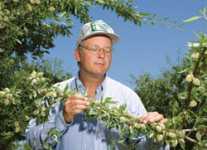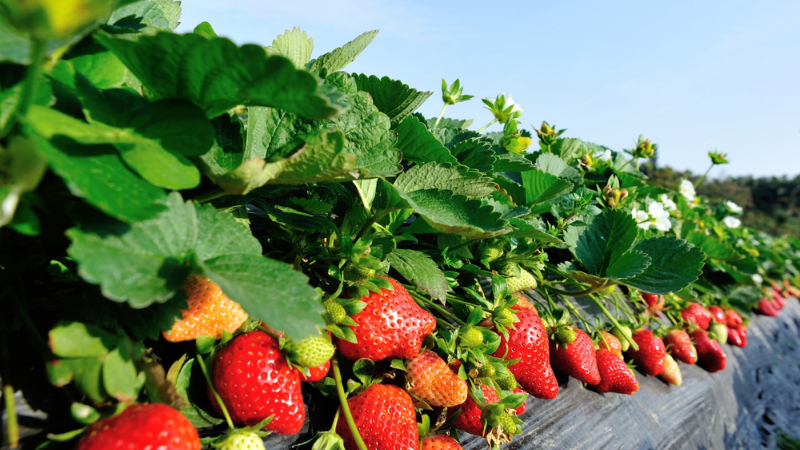No Bees Necessary For Almonds

Craig Ledbetter, a geneticist at the Agricultural Research Service’s (ARS) Crop Diseases, Pests and Genetics Research Unit near Parlier, CA, is developing a new line of self-pollinating almond trees. The new varieties may provide growers with alternatives to traditional bee-pollinated almond trees, in response to the Colony Collapse Disorder (CCD) crisis and other factors in recent years that have dramatically reduced honeybee populations. The line of self-pollinating trees has other benefits, as well, says Ledbetter.
“Self-pollinating almond trees will benefit growers at both bloom and harvest,” he says. “Because they are self-pollinating, only one variety needs to be planted in the orchard, as opposed to two or three in an orchard with conventional cultural systems. The self-pollinating trees will produce almonds with only wind pollination, but of course will produce more with the addition of bees to the orchard. Sometimes bees are in short supply or simply expensive during bloom and the self-pollinating trees will provide a crop, even with the bee shortage. At harvest, with only a single variety in the orchard, the producer doesn’t have the problem of drying down the early-harvest variety while at the same time putting stress on the later-harvest variety or varieties.”
While self-pollinating almond trees are not new — the Tuono variety from Spain has been in production for centuries — Ledbetter’s new line of self-pollinating almond trees has the promise of harvesting almonds that have similar characteristics to Nonpareil, which sells for higher prices.
The older Tuono variety’s seed coat is hairy and it has a very thick shell, making only 32% of the kernel edible, compared to up to 65% for Nonpareil. Conversely, the Tuono’s thick shell is beneficial in that it provides more resistance to navel orangeworm, the primary pest of almonds in California, and other pests. An integrated pest management program to reduce navel orangeworm damage and broad-spectrum insecticide use is underway at the Parlier research facility, led by Joel Siegel and assisted by entomologists Bas Kuenen and Chuck Burks.
Best Of Both Worlds
Though both Tuono and Nonpareil varieties have good characteristics, almonds with traits from both varieties would be ideal, and that’s pretty much what Ledbetter and his collaborators have created. Using Tuono as the male (pollen) parent, conventionally hybridized with California-adapted almond cultivars, the scientists made crosses at bloom time and came back at harvest to collect the nuts. They then grew those nuts into seedlings and surrounded branches with insect-proof nylon bags to exclude pollinator insects. The seedlings bloomed and some produced fruit inside the bags. The scientists knew that these seedlings were the self-pollinators, because no foreign pollen had been introduced into the bags.
Ledbetter and his team planted the first seedlings in 1996, which produced a small harvest; 10 years later the trees produced excellent results. In November 2008, after a very good fall harvest, Ledbetter and his team brought eight promising selections from the self-pollinating breeding program to the Almond Board of California for evaluation of taste and appearance. The board was pleased with the selections’ skin color, oil content, and flavor, as well as the similarities between the selections and the Nonpareil variety.
“What separates the Parlier-developed selections and Nonpareil, of course, is that these ARS almond trees need no external pollination,” says Ledbetter. “Ours is a very good-looking kernel that’s very comparable to that seen in Nonpareil.”
Growers can expect to see the ARS self-pollinating almond trees on the market within the next three years at the very least, following additional yield and quality trials, says Ledbetter.
“We must prove the yield potential and kernel quality of our self-pollinating varieties prior to releasing them to producers,” he says. “If they do not yield sufficiently, and have kernels of acceptable quality, they will be unworthy of production. For our most advanced selections, we have determined that the kernels are of sufficient quality, compared with industry standards (Nonpareil, Carmel, Padre). Currently we are examining yield potential of some of our most advanced selections. With another year of yield data, and assuming the yield remains consistent with past harvests, we will have sufficient data to begin the process of variety release.”










